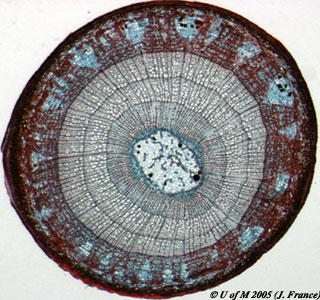
 |
Secondary
Growth
(Canadian Campbell, Concept 35.4) 
In addition to primary growth, many plants undergo additional growth which brings about an increase in the girth of the plant body. Such growth is termed secondary growth and involves the activity of lateral meristems, the vascular cambium and the cork cambium. These meristems become active in regions of the plant body that have completed the primary growth phase. The vascular cambium produces the secondary vascular tissues: secondary xylem and secondary phloem. These tissues are composed of the same cell types as the primary vascular tissues. A vascular cambium is found in roots, stems and in the large vascular bundles of many leaves. The cork cambium is found in roots and stems. The cork cambium produces cork cells which at maturity are non-living and possess heavily suberized cell walls. Suberin is a fatty compound. The cork cambium may also produce small amounts of cork parenchyma. The corkcambium, cork cells and cork parenchyma are collectively referred to as periderm.
Secondary growth is a feature of all gymnosperms and many dicots. Monocots and the seedless vascular plants lack secondary growth from a true vascular cambium.
Examine the prepared slide of Tilia (basswood) stem cut in cross section
Locate the pith, primary xylem, secondary xylem, vascular cambium, secondary phloem, primary phloem, cortex, periderm (cork and cork cambium) and epidermis (if present).
The term bark refers to all the tissues external to the vascular cambium.
A lenticel is a limited region of root and stem periderm in which the cork cambium produces tissue termed "complementary tissue". In contrast to cork, the complementary tissue of a lenticel possesses numerous intercellular spaces. Lenticels function in gas exchange.
![]()
